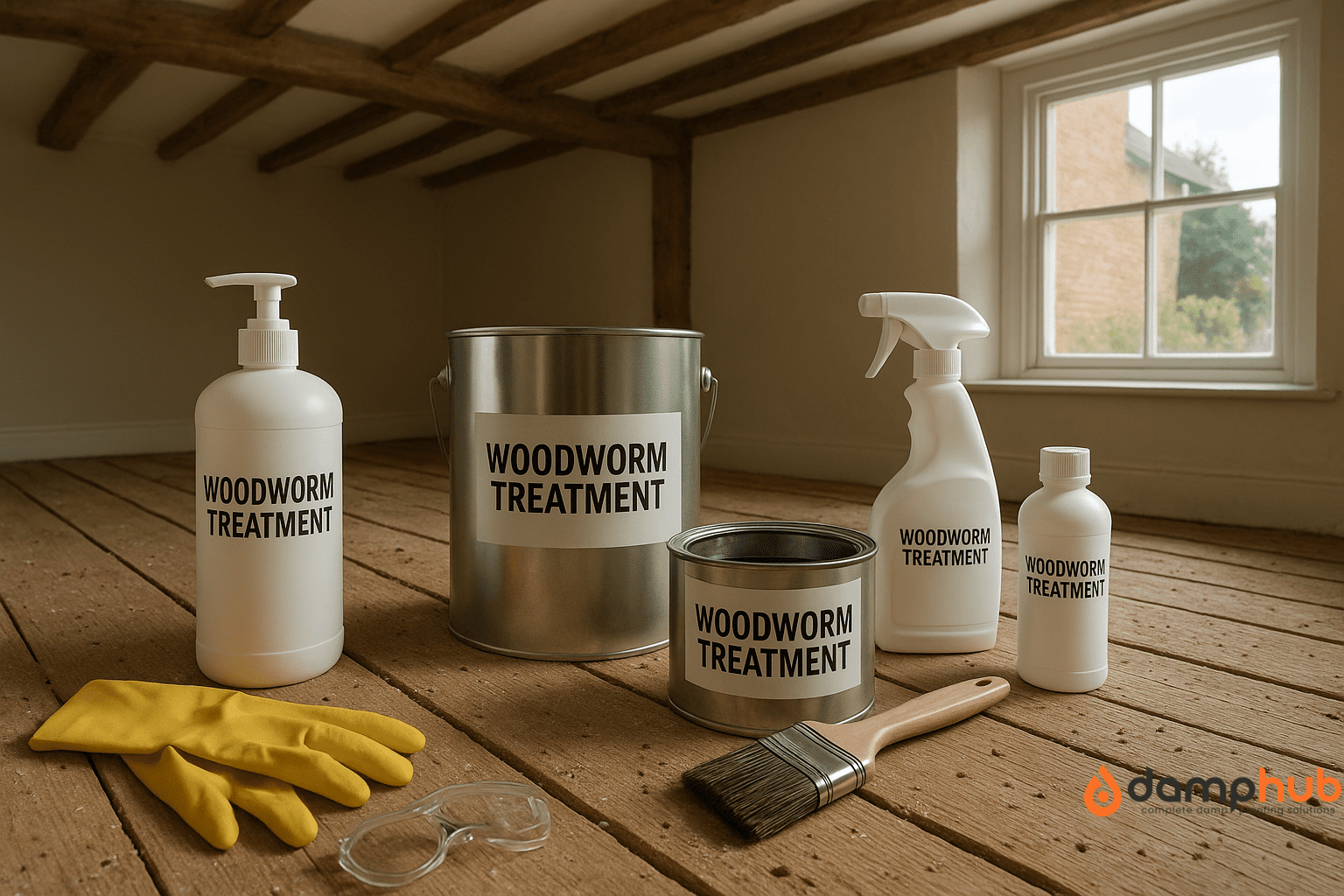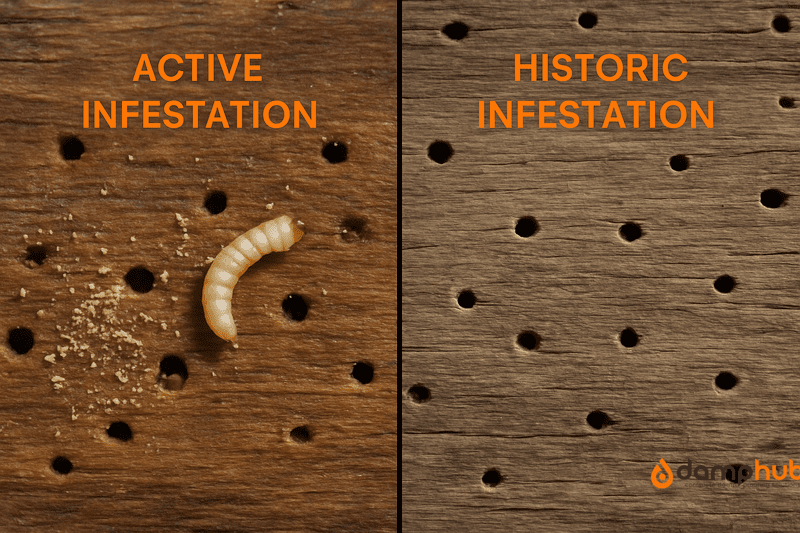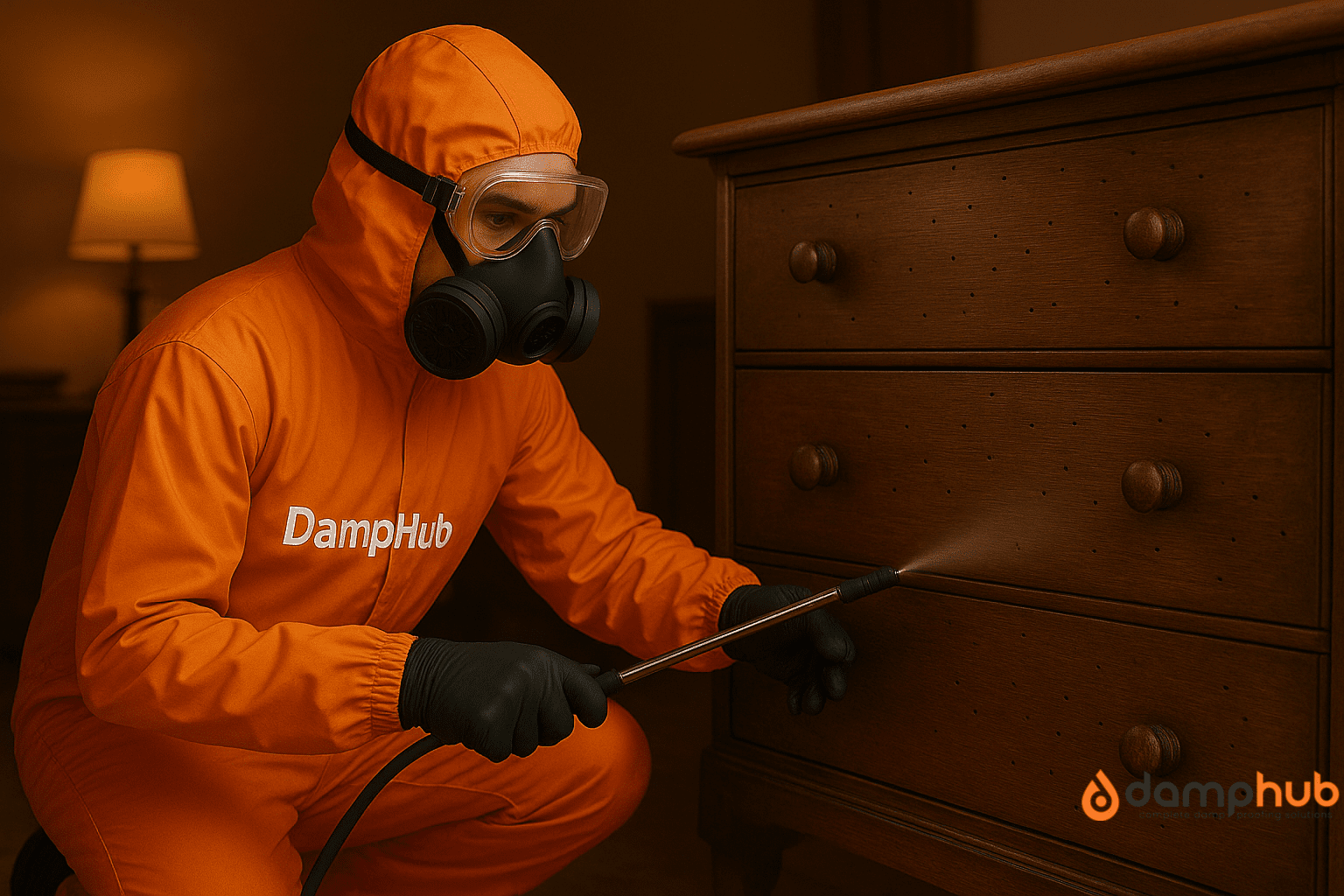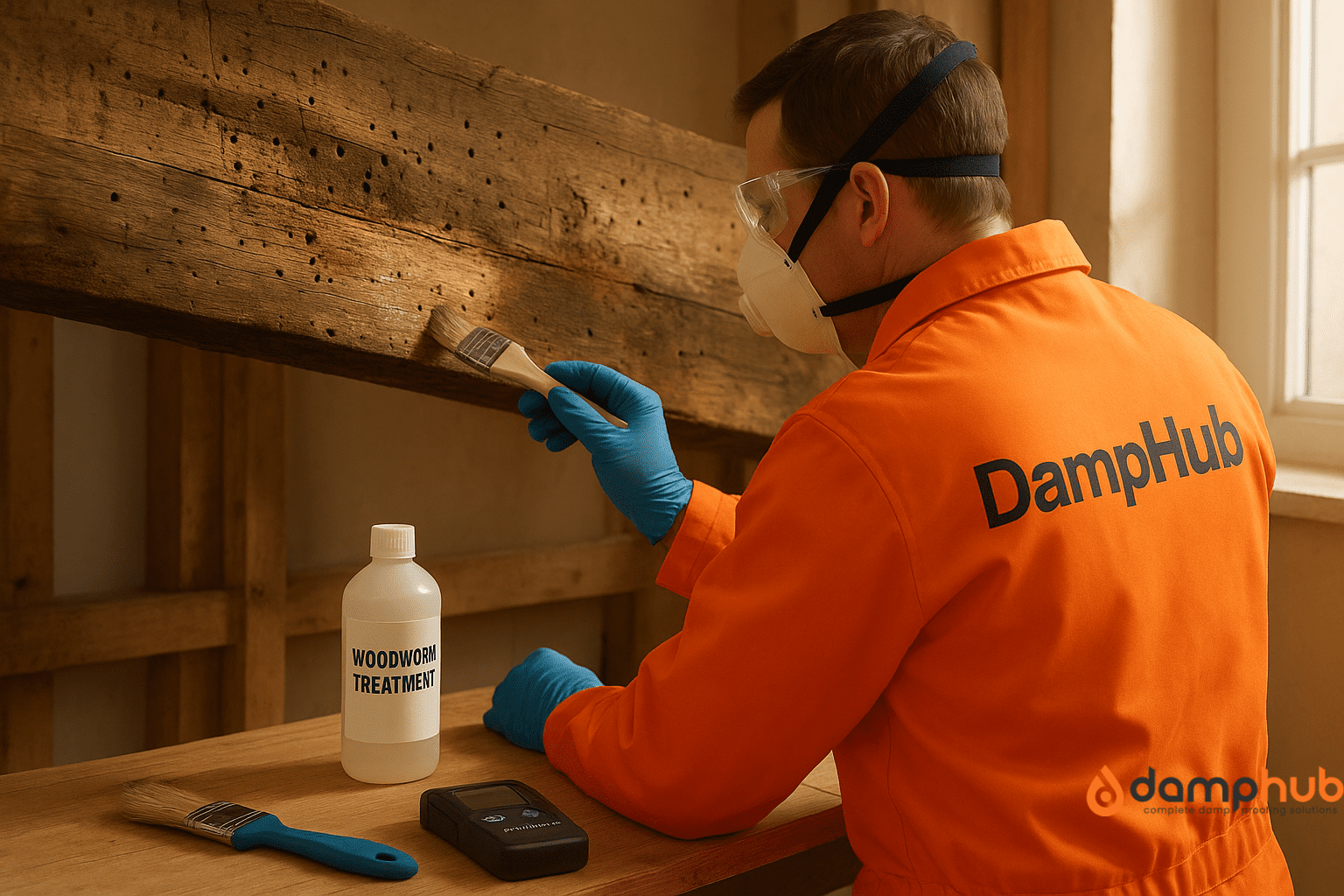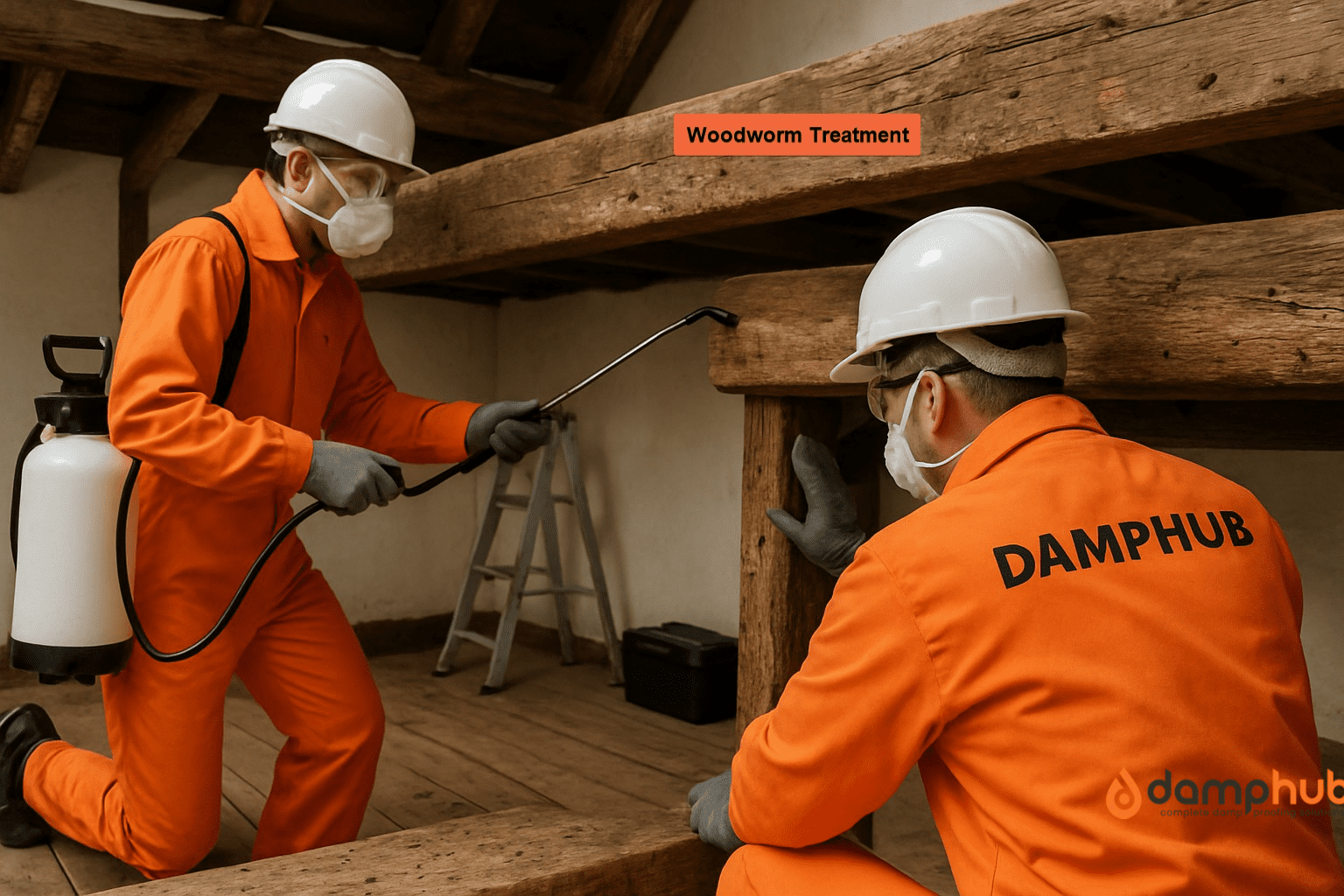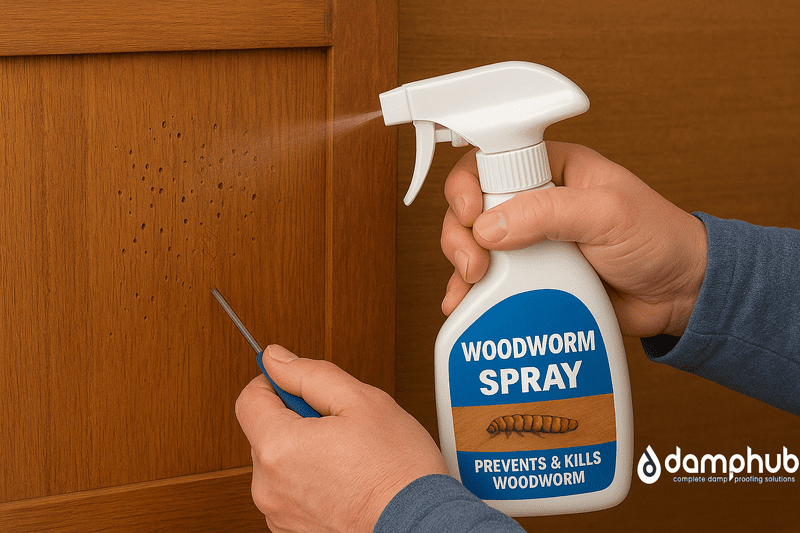
When buying or selling a home in the UK, taking a property survey can help you determine what you are getting into. A property surveyor inspects common issues, such as damp, structural defects, and woodworm infestations in timber, and provides a detailed report outlining the property’s condition.
You receive this report with fingers crossed, hoping for no damages that could turn your dream home into a costly headache. But sometimes, the report reveals a woodworm infestation—leaving you wondering, what should you do when a survey reveals woodworm?
Worry less; this article will guide you through everything you need to know to tackle woodworm with confidence.
1. What is woodworm?
Woodworm usually finds its way into a house in a few sneaky but fairly common ways. In the warmer months, adult beetles emerge from old timber (both outside and in nearby buildings) and fly in through open windows, vents, or gaps.
They are attracted to wood with a higher moisture content, which is why damp lofts, basements, or poorly ventilated rooms are where they infest most. Sometimes, they hitch a ride in infected timber — second-hand furniture, reclaimed beams, or even firewood can carry active larvae or eggs.
Once inside, they lay eggs, which hatch into tiny, hungry larvae that immediately start burrowing through the wood, feeding and tunnelling for several years before emerging as beetles to repeat the cycle.
The larvae feed on timber because it contains the cellulose they need for growth. As they chew through the wood to extract this cellulose, they leave behind a maze of tunnels and fine, powdery dust (frass), gradually weakening the structure from the inside out.
The real danger is how well they hide — most of the damage happens out of sight, so by the time you notice the tell-tale holes or dust, the problem is often far more advanced than it looks.
2. What does woodworm look like?
You probably won’t spot the actual larvae — they stay hidden deep in the timber. What you’re more likely to notice are the signs they leave behind:
- Tiny round holes: These are no bigger than the tip of a ballpoint pen, often scattered across a board or beam.
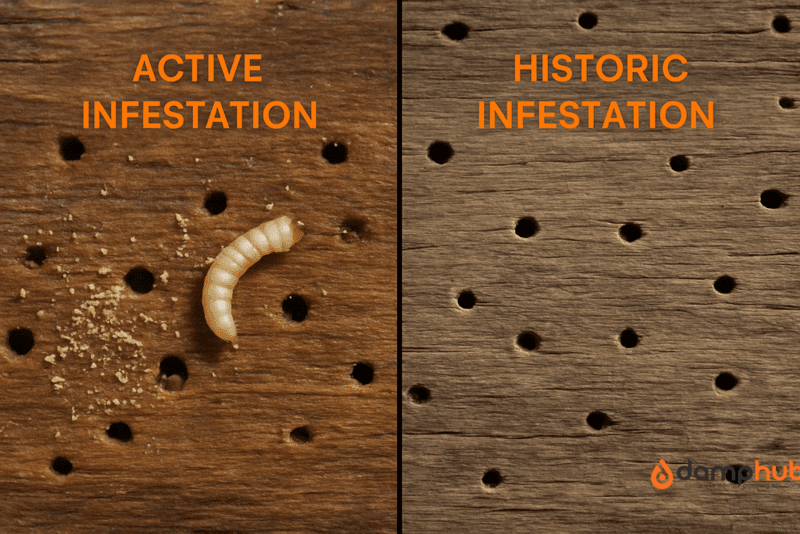
- Frass (A dusting of fine powder): This is chewed-up wood pushed out by the larvae as they tunnel through the grain. Fresh frass is pale and loose; older frass is darker and more compacted.
- Crumbling or soft timber: Press your thumb against an old skirting board, and it might crumble. Floorboards can feel spongy underfoot, and in bad cases, a joist or rafter can splinter with very little effort.
- Adult beetles: On a warm spring day, you might spot one crawling along a windowsill, trying to get outside. Easy to dismiss if you don’t know what you’re looking at — but a big clue that something inside your woodwork is alive and eating.
3. Types of woodworm found in UK homes
Different types of beetle larvae can damage timber in the UK, and each causes problems in its unique way. You need to know exactly what you’re dealing with, as it’s the first step in choosing the right treatment and stopping the damage before it worsens.
Below are the most common wood-damaging woodworm in the UK:
- Common Furniture Beetle: This is small and brown, with tiny, round exit holes about 1–2 mm wide. Attacks most softwoods and plywood, including roof joists, floorboards, and skirting boards.
- Deathwatch Beetle: Larger, with a preference for old hardwoods like oak and elm. Often infests wood that’s already damp or decayed. Found in older buildings such as churches and farmhouses.
- House Longhorn Beetle (mainly in southern England)Targets roof timbers made of softwood. Leaves large oval exit holes. Can hollow out beams until they lose structural strength.
- Powderpost Beetle: Infests hardwoods such as oak and ash. Reduces timber to a fine powder and can re-infest the same wood until nothing sound remains.
4. How does a woodworm infestation start?
It starts quietly. An adult beetle finds a piece of exposed timber and lays its eggs in tiny cracks or old exit holes. That timber might be part of your roof, a floorboard in a spare room, or a second-hand coffee table you’ve just brought home.
When the eggs hatch, the larvae bore straight into the wood and start eating. They don’t come back out for years. All the while, they’re carving out tunnels you can’t see.
As said, they like hiding in damp or poorly ventilated spaces such as lofts, basements, and timber in contact with brick or concrete. The softer the fibres, the easier the bite.
By the time you notice the signs of woodworm, the real work inside is already done. The adults emerge, mate, and the process repeats. That’s why catching it early is more about spotting fresh signs than waiting until the wood looks obviously damaged.
Pro Tip
If you suspect activity, tape a sheet of white paper under the timber in question. Check it after a week. Fresh, pale dust means they’re still at work.
5. What to Do if You Suspect Woodworm
You’ve had a good look around and spotted what you’re pretty sure are woodworm signs: little holes, fine dust, maybe even timber that feels too soft. Don’t shrug it off. These things don’t stop for tea breaks.
Leave it a few months, and you could be replacing whole sections of floor or roof beams. The aim now is simple: stop it spreading, get proof, and bring in someone who knows exactly what they’re dealing with.
- Don’t start moving stuff about – That old beam or chest of drawers you think you’re “rescuing” could be dropping larvae into every room it passes through. Better to keep it in one place than give the problem a tour of your house.
- Get it on camera – Not just one photo. Take close-ups of the holes, the dust (that’s frass, by the way), and any crumbling edges. The more angles you get, the easier it’ll be for a pro to say, “Yep, that’s active” or “Nah, that’s old damage.”
- Check the neighbours… meaning the other bits of wood – Grab a decent torch and have a look at the beams, floorboards, or skirting that connect to the dodgy bit. Don’t just look dead-on; shine the light along the grain to catch anything you’d miss otherwise.
- Sort the damp – Roof dripping? Pipe sweating? Loft like a sauna? That’s a buffet for wood-boring beetles. Patch leaks, open vents, run a dehumidifier — whatever gets the wood dry and unwelcoming.
- Call the experts – Seek a professional who does timber treatments for a living, not a mate with a can of bug spray. They’ll tell you if it’s active, name the beetle, and hit it with something that works.
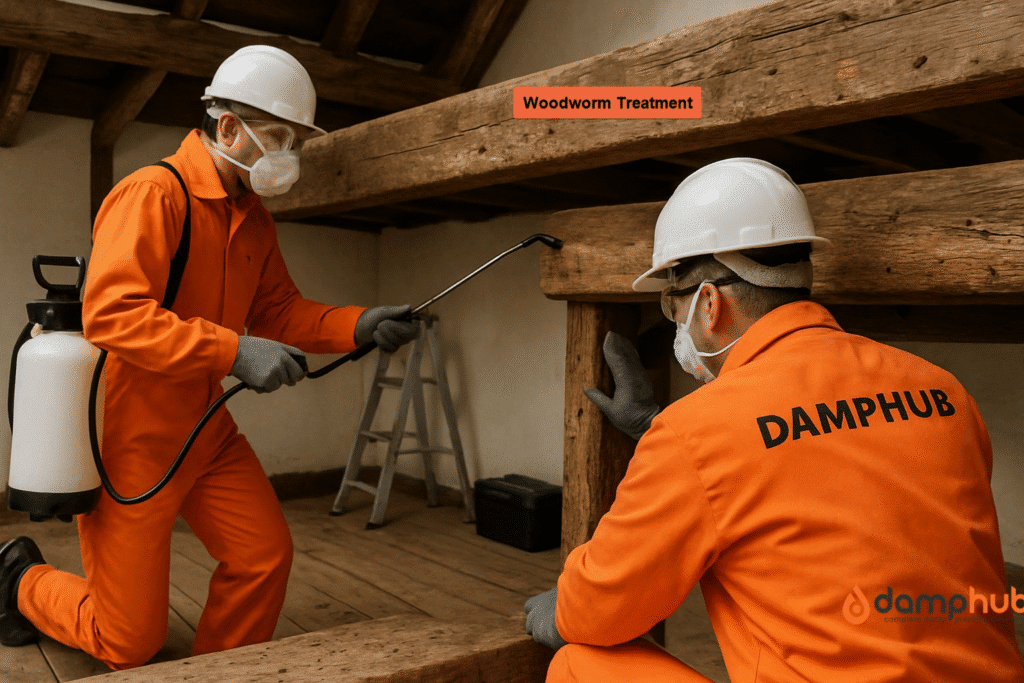
6. How to Tell if Woodworm Is Active
Spotting old holes in wood doesn’t always mean you’ve got a live infestation. Sometimes the beetles have long gone, leaving nothing but cosmetic scars.
The trick is knowing the signs that point to recent or ongoing activity, so you can decide if treatment is urgent. These checks don’t require fancy tools — just good lighting, patience, and a bit of know-how.
- Fresh, pale exit holes – When beetles leave the wood, the edges of the holes are lighter in colour compared to the rest of the timber. Over time, these edges darken, so pale means recent.
- New frass deposits – Brush away the fine, talc-like dust around suspect areas, wait a week, and check again. Fresh dust means something is tunnelling inside right now.
- Adult beetle sightings – Spotting the beetles themselves, usually between late spring and summer, is a sure sign they’ve emerged recently and could be breeding again.
- Soft or crumbly timber – If gentle pressure with a screwdriver tip causes the wood to give way easily, there’s probably been recent boring inside the grain.
- Mark and monitor holes – Circle existing holes with a pencil and keep an eye out. If new ones appear outside the markings, the infestation is still active.
Pro Tip
If you suspect activity, tape a sheet of white paper under the timber in question. Check it after a week. Fresh, pale dust means they’re still at work.
7. Who Can Check for Woodworm
Not everyone who deals with pests is equipped to properly diagnose a woodworm problem. You want someone who knows their timber species, understands building structures, and can spot damage at different stages. The wrong diagnosis could mean paying for treatments you don’t need — or missing one you do.
- Timber treatment specialists – These pros work specifically with wood-based infestations. They can identify the beetle species, measure the damage, and recommend targeted chemical or heat treatments.
- Chartered surveyors – Often brought in for property sales or renovations, they can flag early signs of infestation and produce detailed written reports.
- Pest control companies – Some cover wood-boring beetles, but many focus mainly on eradication. They might not address prevention or repair unless that’s part of their service.
- Check credentials – Look for PCA membership or CSRT certification. These indicate the person is trained, vetted, and works to industry-approved methods.
Our other helpful resource: Who Should Pay for a Damp and Timber Report?
8. What Is a Woodworm Survey
A woodworm survey isn’t just a quick look at a couple of beams. It’s a structured check of your property to map out exactly where the problem is and how bad it’s gotten. The survey also helps prevent treating areas unnecessarily, which saves money and avoids needless disruption.
- Complete property inspection – From attic rafters to basement joists, every accessible timber section is examined for holes, frass, and surface changes.
- Structural probing – Light tapping and probing tools help identify hollow, weakened, or paper-thin wood without causing more damage.
- Moisture readings – Using meters, the surveyor checks if damp conditions are encouraging beetle activity, as high moisture is often the trigger.
- Damage mapping – The survey notes every affected area so treatment can be applied precisely, rather than coating all timber indiscriminately.
- Personalised recommendations – The final report includes advice tailored to your timber type, property layout, and the risk of re-infestation.
You may want to read our other related guide: What Is a Damp Survey? Costs, Process & Why It Matters
9. How Much Does a Woodworm Survey Cost?
This one always gets asked because nobody likes surprises when it comes to their wallet. The price can jump around quite a bit depending on where you are, how big your place is, and what exactly the inspector needs to do.
Some places will just swing by for a quick peek and won’t charge you a penny, but others will want a proper look with a full report.
- Free looks – Loads of pest companies offer a quick, no-strings glance to put your mind at ease. But heads up, they often won’t give you anything official in writing.
- Proper surveys – For the full deal — report, photos, and expert advice — expect to cough up between £80 and £150.
- Extra stuff – Sometimes they might need to lift floorboards or drill into beams, which can push the price up. Best to ask before they start poking around.
How Long Does a Woodworm Survey Take?
Honestly, it depends. A tiny flat? You’re probably looking at under an hour. A big old house with floors, lofts, and tricky spots? It could be half a day or more. The pros need to check all the timber properly — no rushing, no cutting corners.
- Quick checks – If there’s just one suspect area, an inspector might pop in, have a look, and be out in 30 to 60 minutes.
- Full inspections – For big properties, expect 2 to 4 hours to cover everything from the attic to the basement.
- Moving things around – If they have to lift carpets, shift furniture, or climb into awkward spaces, it’ll slow things down, so factor that in.
Related article: How Long Does a Damp Survey Take? A Step-by-Step Timeline
What to Do When a Survey Reveals Woodworm?
Finding woodworm is never fun news, but don’t panic. The key is to sort it quickly before the little blighters eat more wood and rack up your bill. The longer you leave it, the worse it gets — and the harder it is to sell or insure your place.
- Get quotes – Use that survey report and get prices from a few specialists. Don’t just go with the first offer.
- Ask about treatments – Some use sprays, some gels, some heat. Know what’s best for your type of wood and infestation.
- Fix the damage – If the wood’s badly eaten, you might need to patch or replace parts after treatment.
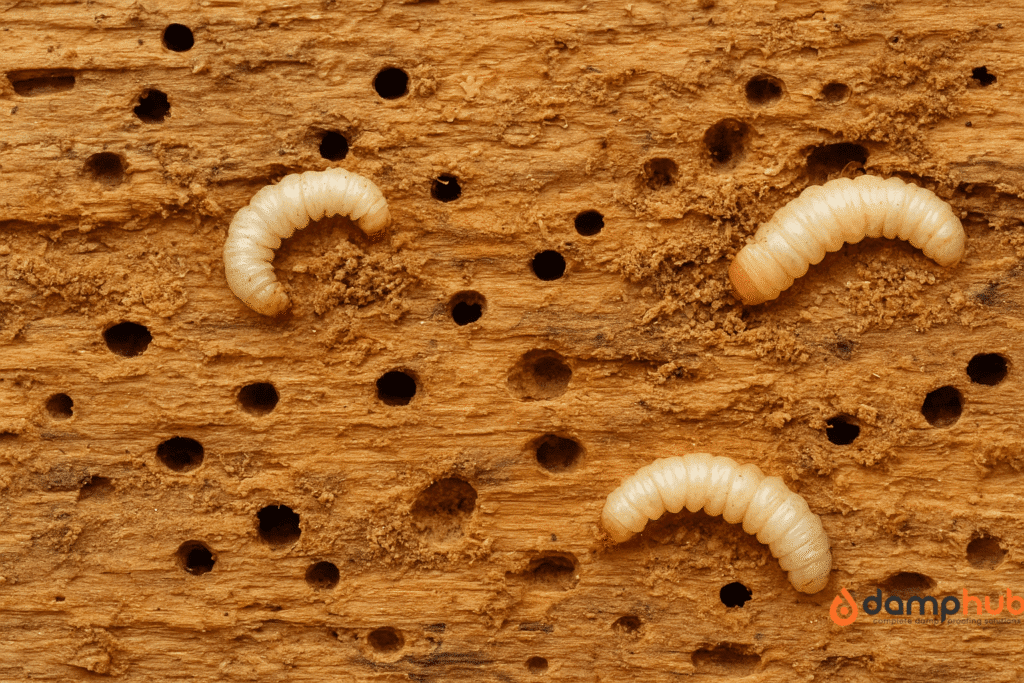
Can You Sell a House with Woodworm?
Yes, but honesty’s the best policy here. Trying to hide woodworm can come back to bite you legally if the buyer finds out later. Most sellers find it easier to treat the problem before listing, so the sale doesn’t drag on or fall through.
- Get a treatment certificate – It’ll reassure buyers and keep your asking price healthier.
- Expect lower offers if untreated – Buyers will factor in the cost and hassle of sorting it themselves.
- Be upfront on paperwork – UK property forms ask about infestations — lying isn’t worth the risk.
Is Woodworm Covered by House Insurance?
Usually not. Most home insurance sees woodworm as a maintenance problem you should prevent, not something to claim for after the fact. Some specialist policies might help, but they’re rare and often pricey.
- Check your policy carefully – Look for any mentions of pests or infestations to see if woodworm is included or excluded.
- Specialist cover exists – Some insurers offer add-ons for pests, but don’t expect this to be standard.
- Prevention beats cure – It’s cheaper and safer to keep an eye out and treat early than hope insurance will cover damage later.
To get more information on whether woodworm is covered by insurance, you may want to read this post by Timberwise: Do Home Insurance Companies Cover Woodworm?
Does Woodworm Affect a Mortgage?
This one trips up a lot of folks. Lenders don’t love the idea of active woodworm because it messes with your home’s value and safety. But it’s not automatically a no-go. If you’ve dealt with it properly, the mortgage people usually come around.
- Active infestations are red flags – Banks get jumpy if the woodworm is still munching away because it’s a risk to the property.
- Show you’ve sorted it – Getting a proper treatment certificate from a specialist can calm their nerves and help your application along.
- Old, inactive damage isn’t usually an issue – If the woodworm’s history and no longer active, most lenders won’t sweat it.
Is it Difficult to Get Rid of Woodworm?
Depends on how bad it is and what beetle you’re dealing with. Some are easy to knock back if you catch them early. Others burrow deep and stick around stubbornly. It’s not impossible, but don’t expect a quick fix if it’s bad.
- Small infestations? Easier to treat – Catch it early, and you’re more likely to fix it with minimal fuss and cost.
- Big problems need pros – Deep-set larvae need chemical or heat treatments that only experts can do properly.
- DIY won’t cut it for heavy infestations – Home remedies might help a bit, but rarely get rid of the whole problem.
Can You Treat Woodworm Yourself? How to DIY Woodworm Treatment
You can DIY woodworm treatment if the infestation’s small and you’re up for a bit of elbow grease. But don’t go thinking a single spray will sort it overnight — woodworm isn’t that forgiving.
You’ll need to commit to several applications over a few weeks, and make sure you’re hitting every nook and cranny where those larvae might be hiding.
- Choose the right stuff – Only use insecticides made specifically for wood-boring beetles. The regular bug sprays won’t cut it here; they can’t reach deep enough or stick around long enough to do the job.
- Prep the area first – Clean off any dust, dirt, or old frass around the holes. That way, the treatment soaks in better instead of just sitting on the surface.
- Apply carefully and thoroughly – Don’t just spray randomly. Use a brush or a spray wand to get into holes, cracks, and joins in the timber — places where larvae hide. Make sure the wood is fully covered but not soaked to the point it drips everywhere.
- Repeat treatments – A one-off won’t usually do it. The larvae hatch at different times, so come back with fresh applications every couple of weeks, following the product instructions, until you stop seeing new signs of activity.
- Keep an eye on moisture – Woodworm loves damp, so while you’re treating, fix any leaks or ventilation problems. Dry wood is way less attractive to beetles and helps your treatment last longer.
- Safety first – Always wear gloves and a mask when handling insecticides, and make sure the area is well ventilated. Some of these chemicals aren’t something you want lingering in the air or on your skin.
Doing it yourself can save money and work for minor cases, but if the infestation is deep or widespread, calling in a pro is often worth it to avoid wasted effort and cost later.
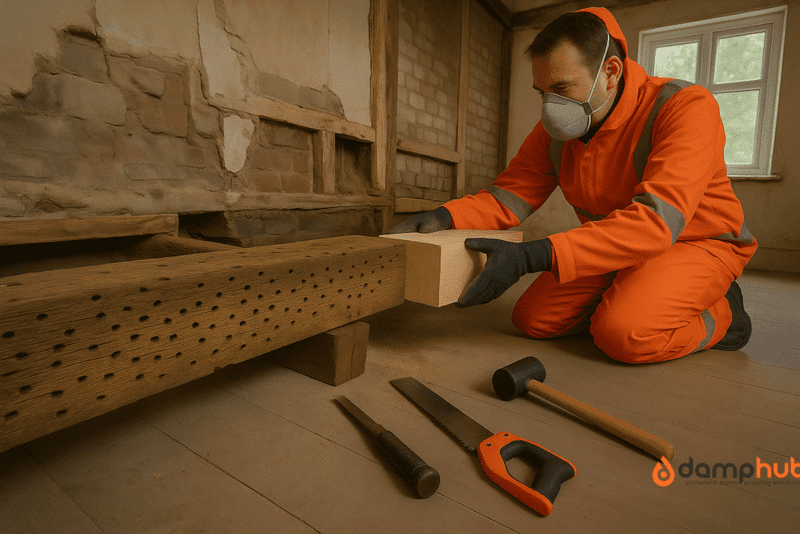
How Much Does it Cost to Get Rid of Woodworm?
This varies a lot. If it’s small and easy, a few hundred quid might do it. If it’s spread through big structural timber, brace yourself for higher costs. Always get a few quotes before signing anything.
- Small jobs on furniture or bits – Usually £100 to £300 tops.
- Whole house treatments – These start around £500 but can climb quickly depending on size and damage.
- Extra work costs more – If you need carpentry or timber replacement, expect the bill to go up.
What to Do when a Woodworm Survey Reveals Woodworm? Questions Answered

What happens if a surveyor misses woodworm?
Well, short answer — it can cost you. If they overlook an infestation, you could move in thinking all’s fine, only to find a few months later your beams look like Swiss cheese.
Sometimes you can go back to the surveyor (if you paid for a proper one) and argue negligence, but it’s messy. More often, you just end up footing the bill for treatment yourself.
How long does woodworm take to show?
That’s the annoying bit — you can have beetle larvae chewing away inside timber for years before you see a single hole. It’s usually when the adults finally emerge (often in spring or summer) that the exit holes appear. So you might think “Oh, it’s just started” when actually… It’s been happening for ages.
What time of year are woodworms active?
Adults do their thing in warmer months — late spring through summer — when they emerge, mate, and lay eggs. The larvae? They’re working 24/7, all year round, quietly munching away while you’re watching Netflix.
Should a Woodworm survey pick up woodworm?
Yes, a decent survey should at least spot the signs: exit holes, frass (that fine dust), weakened timber. But here’s the catch: if the wood is painted, carpeted, or hidden in the roof space, it’s not always obvious, and surveyors aren’t allowed to start ripping your house apart.
How to find the source of woodworm?
Look for clusters of fresh holes (the edges are usually lighter), fine powdery dust near or below them, and any areas where the timber feels soft or crumbly. Also, think about dampness — they love slightly moist wood, so check near leaks, in lofts, or behind skirting.
How to negotiate after a bad survey?
If your survey says “woodworm infestation,” that’s leverage. Get a proper treatment quote and go back to the seller asking for either the repair work to be done before exchange, or a price reduction to cover it. Keep it polite but firm — this isn’t personal, it’s just maths.
Should I share my survey with the seller?
Only the bits you want to. You can use extracts to support your negotiation without handing over the whole document. Remember, once the seller sees everything, they know exactly what you know — which can weaken your bargaining position.
Do woodworms make a noise at night?
Not really in the way you’d hear like termites clicking. You might occasionally hear faint scratching in very quiet conditions if the infestation is heavy, but most people never notice a sound.
Can woodworm make you ill?
Not directly — they’re not like bedbugs or fleas. But the dust from infested wood, especially during treatment or repairs, can irritate your lungs if you’ve got asthma or allergies. Good ventilation and a dust mask go a long way.
How long does it take for woodworm holes to appear?
It can take 2–5 years from the time eggs are laid until the larvae mature and bore out, leaving those little round holes. Which means… the damage you see today probably started years back.

